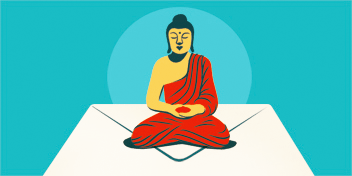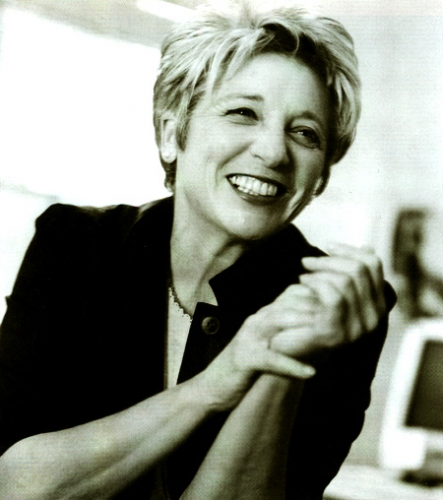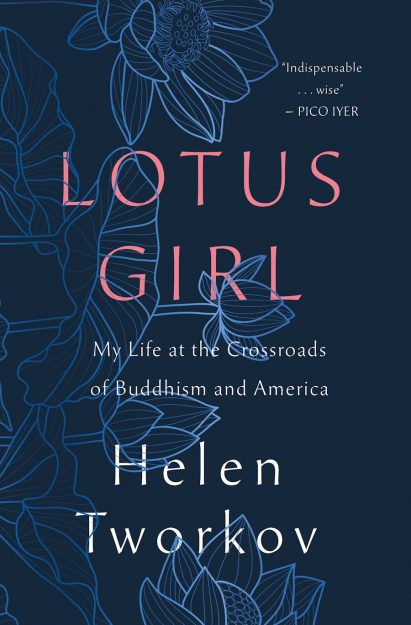Camping alone with [my dog] Inook after splitting up with my husband was never repeated. Friends in Cape Breton had arrived at a consensus that the campsite was too isolated, perhaps a little dangerous. For the next five summers, I lived in a cabin that was built for me on Hermine and Bob’s land. Philip [Glass] did most of the carpentry aided occasionally by Richard Serra, whose own house was nearby, and Rudy paid for the materials. It measured twelve by sixteen feet, with views of the seaway, no indoor plumbing, running water, or electricity, but perfect nonetheless. To take a shower, I walked down to the cove below and stood under the cold waterfall. I no longer craved a haven to hide in, but got one anyway.
I moved into the cabin in August 1977. Then I became so enamored with it, so thrilled to call this little hermitage my own, so mesmerized by the view, so pleased with myself for making my way through the woods at night with my white dog and a flashlight, and at the same time stunned, overwhelmed by gratitude for the friends who had made this possible, especially Philip—who spent hours carrying lumber down the little path, sawing, measuring, hammering. So stunned that it made my appreciation hard to process, and my expressions of gratitude awkward. All of which conspired to keep me kind of stuck there. I just couldn’t leave. Rather than experience this attachment as a contradiction to taking the refuge vow in the home-leaving ceremony with Dudjom, I interpreted its monastic simplicity to perfectly accord with the vows, especially as I did not even own the land it had been built on. By the middle of October, the weather drove me away. And then I still felt too rooted in Cape Breton to leave and moved half a mile up the road to Richard’s wreck of a farmhouse, the house that neighbors said was haunted.
This predated the renovations made by Clara Weyergraf, the German art historian who became Richard’s wife a few years later. Yet even then the house had electricity, indoor plumbing, a telephone, and a coal-burning stove. I was enjoying the upgrade when Richard telephoned to ask me to consider returning to New York to work with him on a new project. He had been invited to submit a proposal for a site-specific sculpture by the Pennsylvania Avenue Development Corporation (PADC), which had been assigned to administer the design of what became Freedom Plaza. This prime piece of Washington, DC, real estate sits adjacent to Pennsylvania Avenue, a few blocks from the White House. The PADC included architects and landscape designers who would assemble for meetings in Washington under the leadership of Carter Brown, then director of the National Gallery. I accepted Richard’s offer without ever imagining the sly, stealth presence of dharma in the White House that would come of it.
***
For the PADC commission, Richard determined to study the site from every angle, from the windows of buildings that overlooked the site, including the old post office and the United States Treasury, and from construction platforms placed in the middle of the avenue that extended thirty feet into the air. I obtained permits for the lifts from the city government with the stipulation that we only work from six to eight o’clock on Sunday mornings, under the protective custody of the police, who closed the streets to traffic.
Two lifts were placed on Pennsylvania Avenue, and Richard moved swiftly between them, always carrying a notebook. With his craggy good looks and belligerent jaw, he stood thirty feet in midair, peering into the morning light with the fiery resolve of Ahab on the deck of the Pequod, absorbing the measure of every angle, corner, width, and height of each form within his sight.
The architect Robert Venturi, a member of the PADC team, submitted a proposal that included two steel pylons. In addition to this shameless appropriation of the sculptural language of Richard’s own work, the pylons framed the US Treasury Building. At the following meeting, and with photocopies that I had located at the public library on Forty-Second Street, Richard compared Venturi’s design to Albert Speer’s architecture in which similar columns glorified the Third Reich by their strategic framing of government buildings. Venturi’s pylons had not drawn attention to the White House or the Lincoln Memorial or any historic symbol of democracy or political freedom. His design focused attention on money, materialism, capitalism, and greed.
Is that really what you want to glorify? Richard asked.
That put an end to Venturi’s pylons, but Richard’s proposal wasn’t getting any traction either. Richard has a deserved reputation for playing rough, yet for the nation’s capital he had examined the site with deeply felt sincerity and had articulated an aesthetic clarity that had eluded his colleagues. And when least expected he could show remarkable restraint. At the last PADC meeting to which his presence was requested, the architect Denise Scott Brown asked Richard if, in place of his rolled-steel rectilinear plate, he might consider a more mollifying design: Would you consider a fountain, Richard? He kept his eyes down and said quietly, I don’t do water.
Two years after the PADC debacle, Richard was invited to the White House to attend a gathering of artists and art administrators. Clara was in Germany waiting for her US legal residency papers and concluded that reentering the United States might jeopardize this process. Richard invited me to join him, joking of our triumphant return to the capital.
It is the working of karma: positive intentions enhance possibilities for positive results.
To John Giorno, my invitation to the White House warranted Dudjom Rinpoche’s attention. Tibetans place great faith in planting karmic seeds, even if the results might not manifest for years, decades, or centuries. It is the working of karma: positive intentions enhance possibilities for positive results. Giorno, an outrageous, transgressive, gay figure of ultra-cool art and poetry circles, was simultaneously an old-school traditionalist when it came to dharma orthodoxy, and he was one of Dudjom’s most genuinely devout students. John viewed my visit to the White House as a supreme opportunity for bringing blessings from a dharma king, an enlightened living buddha, to the headquarters of American power and international sovereignty. In effect, this continued the dissemination of the dharma as it had always traveled: from India to Tibet, and to China and Sri Lanka and Southeast Asia and Korea and Japan, with pilgrims, devotees, and lackeys moving anonymously through corridors of power, negotiating for patronage and salvation.
I arrived at the White House wearing a new champagne-colored organza mid-calf shirtwaist with a mandarin collar, and carrying a beaded purse I had borrowed from my mother. The purse contained a gau—a portable shrine favored by Tibetans that I had first seen around Tenzin’s neck in Kathmandu some twelve years earlier. Tenzin, who had given me my first mala and, calling me Lotus Girl, had told me to take Buddha beads to America. I wore this mala, invisible under my dress, although a red protection cord—a strand of thin string blessed and tied around my neck by Dudjom Rinpoche—was visible at my throat.
The elaborately embossed silver gau measured about two by three inches and had a window in it through which a deity could be seen—and could see out. John handed me the gau wrapped in white silk, having had it blessed by Dudjom Rinpoche with aspiration prayers, mantras, and incense. John then suggested that at every opportunity I hold the purse as high as possible and rotate my hand from the wrist to disperse the blessings far and wide.
Vice President Walter Mondale and Mrs. Mondale hosted the subdued event. At one end of a formal reception hall a quartet played classical music. We strolled around, trying to pretend we belonged there. The only guest I knew was my mother’s first cousin, Harvey Lichtenstein. By then Harvey was ten years into his long tenure as executive director of the Brooklyn Academy of Music, during which he single-handedly—more or less—and ingeniously redrew the cultural map of New York City. It was Harvey’s mother, Jenny, who had introduced her brother Max—my grandfather—to her coworker at the garment factory, the grandmother who had spent most of her life in an insane asylum. Harvey had always known the secret of my mother’s mother, and for this reason, my mother had held him at bay. By now, we all knew this fraught history, but it sat between Harvey and me with unacknowledged discomfort. Meanwhile, I kept the purse pressed against my chest and intermittently swung my arm open from the elbow in imitation of the insouciant glamor of 1940s movie stars.
With no announcement, President Carter made a spontaneous appearance. Guests angled for a front-row position. All eyes were on the president, leaving the gau free to radiate its magic, and when it came my turn to shake the president’s hand, it was easy to brush the purse along his sleeve. The secret mission had been a source of amusement to me, certainly not shared with Richard. That such subversive intentions had eluded notice played right into my childhood fantasies of life as a secret agent. But for all the self-cherishing dramatic appeal, I had no idea what might come of this.
In old Tibet, according to legends, enlightened masters flew through space and transferred their consciousness to ravens and dogs, using omniscience to generate benevolence and bestow blessings. Thinley Norbu said, In old Tibet, everyone knew how to fly. I took as a given that I did not know what a liberated mind could do, where it could go, what it could achieve—how far the mind could travel beyond what the eyes saw, what the ears heard. I could not say whether world peace would be more swiftly realized because of Dudjom Rinpoche’s aspirations, or if his blessings could help subvert America’s romance with violence, or if Buddhist teachings could help tame the United States or be a force for peace or racial equality or help us treat each other with more kindness. Could Buddhism help America become America? I hoped that it could.
After President Carter’s walk-through, I left Richard in the reception hall and descended a wide marble staircase to use the powder room, as it was designated. The corridor was surprisingly empty, save for two handsome young honor guards, one Black, one white, standing sentry at either side of the bathroom door, decked out in caps, fitted white jackets with gold buttons, and white pants. I passed through, assuming that the bathroom sentries were standard White House protocol. To the left were three stalls, to the right, three sinks set into a green marble counter, and above them, one long, rectangular mirror. The door to one stall was closed.
A peculiar phenomenon that women experience when urinating relates to sound. A woman who has peed into a water-filled toilet bowl with an adjacent stall in use might think she is still peeing when actually it is only the sound that has not stopped, but it is coming from the next stall. Such was the case at the White House, so that after the occupants finished fussing with underpants and pantyhose, two stall doors opened at once. As we stood at our separate sinks, I looked into the mirror and discovered that the sweet moment of merged identities had been shared with Lady Bird Johnson.
I focused on faucets, heart racing, then soap, and the habit of hand motions at a sink. My temples throbbed. I peeked up at the mirror: I voted for your husband, I said silently. My first time voting for a president. That meant something to me. Sixty thousand Americans dead, millions of Vietnamese. Was he sorry? Did he cry in his sleep?
We dried our hands. Refreshed our lipstick. She looked like a nice lady. Dyed black hair, lacquer sprayed. Jeweled choker. She smiled into the mirror. Her wide mouth made for a generous smile. I smiled back. She stepped out first and walked ahead, closely flanked by her honor guards.
Fifty paces back I waved my beaded purse wildly in a gesture big enough to discharge cannons of anger and hope. I waved to wake that motherfucker from the dead, waved my blessed amulets to dispel the betrayals of my country and waved them so that I too might be tamed by Dudjom Rinpoche’s prayers for pacification. I joined Richard upstairs, and we left the White House in time to catch the last flight to New York.
In Crazy Wisdom, a documentary about Chögyam Trungpa Rinpoche, one of his earliest American students, Jim Gimian, tells of a dialogue that took place in about 1973. Amid rampant talk about the Vietnam War, a young man asked Trungpa to talk about aggression in America. He replied, I want to talk about the aggression in this room. Photographs suggest the aggression in that room was embodied by women and men with tender gazes, flowing hair, beads, and ribbons. And their guru asked them to look at their own aggression. The aggression in this room, in your mind, in my mind. This aggression that cannot be explained or justified by the Vietnam War. Let’s talk about this aggression that has no point of origin and cannot hide be- hind beards and beads.
I had never entertained the possibility that in order to disarm anger on the outside, first you had to deal with your own.
During the war, anger provided credibility. The more anger you expressed, the more passionately you cared about justice, about dead Vietnamese babies and villages destroyed by napalm. Anger was the Purple Heart worn in our mouths. We denounced war but venerated rage against the war, especially from campus firebrands. We could call for peace, chant Make love, not war, flash the V sign, and offer flowers to riot squads. But we did not know how to be peace—how to inhabit a steady mind, calm in the midst of turbulence, not buffeted between what we did and did not like, between good and bad, between aversion and attraction. We didn’t know how to confront anger without being angry, so that for all our good intentions, we increased the collective density of anger in the atmosphere.
I had never entertained the possibility that in order to disarm anger on the outside, first you had to deal with your own. It’s like the flight attendant on an airplane giving instructions for the emergency use of oxygen masks: Put on your own mask first before trying to assist others. The Buddhist message that arrived at the height of the Vietnam War was that lasting freedom could be realized by taking responsibility for our own states of mind—under any and all conditions. Look at the Dalai Lama. Look at Gandhi; at Martin Luther King, Jr. We had the capacity to free ourselves from the destructive mind states of aggression, anger, and revenge. Don’t use an unjust war to justify your angry mind. No situation, we were told, inherently, immutably determines its reaction. We act as if it does. In the midst of America’s most divisive war, Asian Buddhist teachers insistently suggested that the righteous moral satisfaction that we enjoyed from protest was another way to aggrandize our own egos. In so many words, the teachers kept telling us: Actually, we Buddhists have been doing these mind-training practices for thousands of years. And you Westerners might consider learning something from us, because honestly you are all so crazy and speedy and uptight and busy and aggressive.
◆
From Lotus Girl: My Life at the Crossroads of Buddhism and America by Helen Tworkov © 2024. Reprinted with permission of St. Martin’s Publishing Group.
Thank you for subscribing to Tricycle! As a nonprofit, we depend on readers like you to keep Buddhist teachings and practices widely available.


